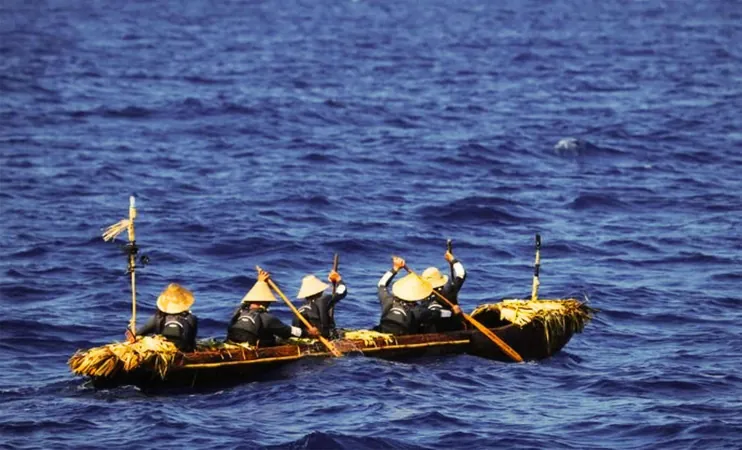
Unveiling Ancient Mariner Skills: Scientists Embark on 225 KM Canoe Journey from Taiwan to Japan
2025-07-03
Author: Ying
A Quest Through Time: Recreating the Great Crossing
In the lush forests of eastern Taiwan, a dedicated team of scientists has embarked on a groundbreaking journey to answer a question that has baffled archaeologists for centuries: How did Paleolithic humans manage to navigate vast oceanic expanses to reach the remote islands of southern Japan? Their quest culminated in an ambitious experiment that beautifully intertwined modern science with ancient history.
The Bold Voyage Begins
Led by Professor Yousuke Kaifu from the University of Tokyo, this remarkable expedition set out to recreate one of humanity's earliest sea crossings. The voyage covered approximately 225 kilometers over the open ocean, starting from eastern Taiwan and destined for Yonaguni Island in Japan. In a bid for authenticity, the researchers constructed a 7.5-meter dugout canoe using replicas of 30,000-year-old stone tools.
Crafting a Canoe with Ancient Techniques
The construction of this extraordinary canoe began in 2019. Using a single Japanese cedar log felled with a specially crafted Paleolithic axe, artisans hollowed it out painstakingly. This public exhibition took place at Tokyo’s National Museum of Nature and Science, where craftsman Kunihiro Amemiya donned handmade animal hide clothing to showcase ancient woodworking skills. Actress Hikari Mitsushima, who hails from Okinawa Prefecture, participated in the event, emphasizing the emotional connection to the past, saying, “Each stroke of the tool leaves behind the memories of those who crafted it.” The completed canoe, named Sugime, was meticulously designed to endure the challenges of the open sea.
Navigating the Unknown with Ancient Instincts
In a remarkable 2025 endeavor, the team launched Sugime into the East China Sea, aiming to trace the ancestral migration route of early humans. For over 45 hours, they paddled without maps or modern navigation tools, relying solely on the sun, stars, ocean swells, and their innate instincts to guide them. Their journey culminated successfully at Yonaguni Island, despite almost total obscurity of land throughout the crossing.
Ancient Paddlers: Skilled Explorers of the Seas
The researchers concluded that our ancient ancestors likely possessed advanced seafaring skills. Professor Kaifu stated, “We’ve discovered that these canoes are not just fast but remarkably resilient for such crossings. However, strong paddling experience and effective strategies were vital for those early explorers.”
Innovative Simulations Illuminate Ancient Strategies
To complement their physical journey, the team conducted extensive virtual simulations. These high-tech models factored in ancient ocean conditions, testing diverse departure points, seasonal influences, and paddling techniques. The simulations revealed that starting from northern Taiwan significantly increased success rates for crossings. A crucial realization emphasized the need to angle slightly southeast rather than paddling straight toward the destination, effectively countering the powerful Kuroshio Current.
Rethinking Human Migration in Prehistory
The findings from this study bolster the hypothesis that early modern humans skillfully migrated to the Japanese archipelago via canoe. Traditional archaeological evidence, like artifacts and skeletal remains, often fails to paint a complete picture due to the ocean's tendency to wash away traces of ancient life. Through experimental archaeology, this innovative research sought to fill those critical gaps, inviting us to rethink our understanding of early human exploration.






 Brasil (PT)
Brasil (PT)
 Canada (EN)
Canada (EN)
 Chile (ES)
Chile (ES)
 Česko (CS)
Česko (CS)
 대한민국 (KO)
대한민국 (KO)
 España (ES)
España (ES)
 France (FR)
France (FR)
 Hong Kong (EN)
Hong Kong (EN)
 Italia (IT)
Italia (IT)
 日本 (JA)
日本 (JA)
 Magyarország (HU)
Magyarország (HU)
 Norge (NO)
Norge (NO)
 Polska (PL)
Polska (PL)
 Schweiz (DE)
Schweiz (DE)
 Singapore (EN)
Singapore (EN)
 Sverige (SV)
Sverige (SV)
 Suomi (FI)
Suomi (FI)
 Türkiye (TR)
Türkiye (TR)
 الإمارات العربية المتحدة (AR)
الإمارات العربية المتحدة (AR)